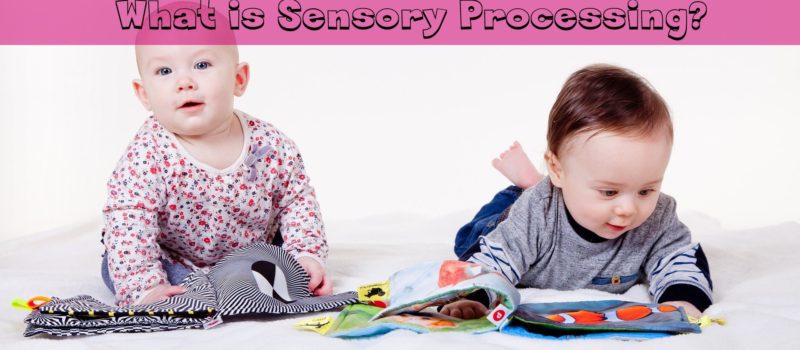
Sensory Processing in Children
Special thanks to guest columnist Denise Wagner (OT)
As a kid, some of our most memorable childhood moments probably involve some form of sensory processing…the twinge in your stomach while soaring in the air on a swing, the thrill of gliding and speed as you rip down a hill on a toboggan/crazy carpet, the stumbling and laughter from playing spin the bat, cranking up the volume to your favourite tunes through headphones, or the excitement of feeling and seeing pop rocks explode on your tongue. All of these experiences involve “sensory processing”, and sensory processing is a vital/essential part in the growth and development of a child’s physical, mental, emotional, and social skills.
A child takes information in from their surroundings and builds on their skills through their senses and body. The processing of sensations is very individualized and personal, and the level of comfort, excitement, anxiety, or fear that a child experiences to sensations can impact how they physically respond and emotionally react. Certain sensations that are pleasurable or seem harmless to some individuals can be overwhelming and highly stressful to others. For example, some children love the squish of mud through their toes and fingers; others can’t stand the texture or messiness of the mud and either need to wash up immediately or totally avoid such activities.
What is sensory processing?
In general, sensory processing refers to how a child reacts to their world through their senses; how their brain and body receive, process, and respond to sensory input. The brain and body try to filter and organize the sensory information to make it comfortable, and understandable, and meaningful, which then allows for a plan or motor sequence to be developed in response to that sensory input. As a child grows and learns, the various experiences and exposure to different sensations often result in progressive comfort/tolerance, skill development, and self-confidence. Responses and reactions can be generalized to new environments and challenges, to the point that the responses and reactions, expected or unexpected (positive or negative, reasonable or unreasonable) become automatic or subconscious.
The 8 systems
There are eight sensory systems involved with sensory processing: visual (sight), auditory (hearing), oral (taste), olfactory (smell), tactile (touch), proprioception (body and spatial awareness, posture, motor control), vestibular (information about movement in response to gravity and changes in head position), and interoception (awareness of sensations from within the body that relate to the current state or condition that it is in; e.g., hunger, feeling hot or cold, needing to use the washroom, increased heart rate, etc.). These sensory systems work alone and/or together. Sensory processing impacts a child’s overall skill development, including physical abilities, attention and focus, emotional awareness, and social interactions.
Regulation
Over time, a child develops an awareness that different sensations and actions can help them to feel more comfortable and/or calm, and they will seek out or use those sensations and activities to help themselves regulate. Regulation strategies can be self-directed (e.g., thumb sucking, curling up into a blanket, chewing on gum, etc.), and they can also be encouraged or coached (e.g., a parent offers a hug to comfort an upset child; a teacher has a classroom movement break to either calm a rambunctious class or to rev up/refocus a distracted classroom; deep breathing and mindfulness strategies can be taught to help cope with anxiety).
Indications of Sensory Issues
Challenges with sensory processing often start in childhood, and may or may not change or diminish as a child grows. Signs of sensory challenges can be quite variable between children, and can be quite variable within a child as they encounter different types of sensory input with different environments and/or tasks over different periods of time (e.g., a child can be grumpy and unsocial during breakfast, but becomes pleasant and talkative during lunch). Sensory processing issues can impact the way a child learns, explores, communicates, and behaves. Some indications of sensory issues may be attention difficulties, challenges in following through with daily tasks and routines, emotional outbursts or tantrums, dizziness or nausea, anxiety, lethargy, and frustration or avoidance with certain situations or activities (e.g., avoids working with paint or glue; distress with different foods touching each other on the plate, etc.).
How Do I Know What is Normal
Further assessment and intervention is recommended when a child’s reactions and/or challenges are severe enough to significantly impact their function and participation (and possibly that of their family) in daily tasks, activities, routines, and interactions. Sensory processing assessment can help to identify which sensory system(s) may be impacting a child, and whether the child’s sensory system is over-aroused (hypersensitive), under-aroused (hyposensitive), or a combination of both. Sensory interventions can increase a child’s tolerance, decrease anxiety, and expand a child’s and family’s coping strategies by providing tools and activities for calming/alerting, enhancing body awareness, developing a sensory/emotion vocabulary, and establishing sensory routines.
Over
Over-arousal suggests that there is too much stimulation, and the child’s body struggles to filter or “tune out” sensory information. A child can be overly sensitive to certain forms of sensory stimulation, and they can become “Sensory Avoiders” because they try to protect their body and nervous system from being overloaded. Hypersensitive children may seek isolation or quiet spaces, struggle with light levels, be distracted by background sounds (e.g., the ticking of a clock or the buzzing of a light), avoid certain textures and clothing, be fearful of changing positions or moving around, resist being cuddled or hugged, and may readily experience motion sickness or car sickness.

Under
Under-arousal suggests that the body’s filters are too strong, and the child needs more stimulation and time to process sensory information before they are aware or can respond. They become “Sensory Seekers” because their body and nervous system are under-responsive, and they are “craving” sensory information to help know or “feel” what their body is doing, and to plan their responses and actions. Hyposensitive children may appear to be constantly changing positions or moving around, bump into objects or people, invade other people’s spaces, seek spinning or deep pressure (e.g., hugs, crashing into pillows or mats, etc.), enjoy climbing and hanging upside down, mouth or chew on toys and clothing, push or pull on furniture, fidget, rub, or tap on things, and don’t cry or have a high tolerance for pain and injury.
Leading Edge in Pediatrics
Interventions for a Sensory Avoider/Hypersensitive child may explore sensations and activities that decrease their reactivity and arousal, while strategies for a Sensory Seeker/Hyposensitive child may involve activities that increase their arousal/awareness and reactivity. For some children, their sensory processing and coping may grow and change through exploration, play, and learning…they expand their self-awareness, understanding, and sensory strategies, and eventually learn to use their own tools for self-regulation. Other children may require different types and intensities of sensory interventions, and they may need specific routines, direct teaching, and adult coaching or prompting to effectively use sensory strategies; they may or may not become completely independent in self-regulation. The key factors for interventions are finding calming and/or alerting strategies that support a child’s engagement, participation, and interaction in their daily activities and routines.
If your child is facing challenges with sensory processing, please contact us. Our Pediatric Program is here to offer a helping hand.
This information is not meant to replace the advice or treatment of a qualified physician, physiotherapist or occupational therapist. It is meant for information only. Please seek an assessment and discuss your treatment options with your caregiver prior to making a decision about your treatment path.
![]()
